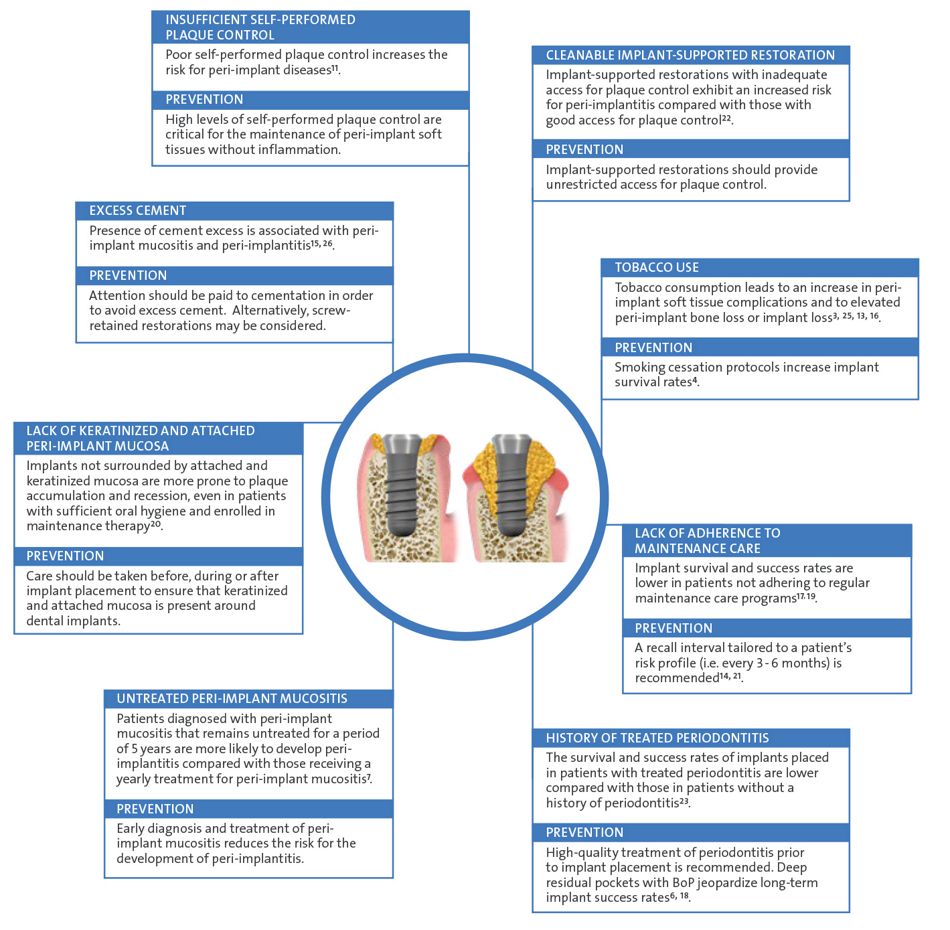1. Araujo MG & Lindhe J. Peri-implant health. (2018). J Clin Periodontol 45:S230–236.
2. Aguirre-Zorzano LA, et al. Clin Oral Implants Res. 26:1338–1344.
3. Bain CA. (2003). Periodontol 2000. 33:185-193.
4. Bain CA. (1996). Int J Oral Maxillofac Implants. 11(6):756-759.
5. Berglundh T, et al. (2018). J Clin Periodontol. 45 Suppl 20:S286-S291.
6. Cho-Yan Lee J, et al. (2012). Clin Oral Implants Res. 23(3):325-333.
7. Costa FO, et al. (2012). J Clin Periodontol. 39(2):173-181.
8. Dalago HR, et al. (2017). Clin Oral Implants Res. 28:144–50.
9. Daubert DM, et al. (2015). Prevalence and predictive factors for peri-implant disease and implant failure: J Periodontol. 86:337–347.
10. Derks J, Tomasi C. (2015). J Clin Periodontol 42:S158–171.
11. Ferreira SD, et al. Costa FO. (2006). Prevalence and risk variables for peri-implant disease in Brazilian subjects. J Clin Periodontol. 33(12):929-935.
12. Konstantinidis IK, Kotsakis GA, Gerdes S, Walter MH. (2015). Cross-sectional study on the prevalence and risk indicators of peri-implant diseases. Eur J Oral Implantol 8:75–88.
13. Heitz-Mayfield LJ & Huynh-Ba G. (2009). History of treated periodontitis and smoking as risks for implant therapy. Int J Oral Maxillofac Implants. 24 Suppl:39-68.
14. Heitz-Mayfield LJ & Mombelli A. (2014). The therapy of peri-implantitis: a systematic review. Int J Oral Maxillofac Implants. 29 Suppl:325-45. doi: 10.11607/jomi.2014suppl.g5.3.
15. Linkevicius T, Puisys A, Vindasiute E, Linkeviciene L, Apse P. (2013). Does residual cement around implant-supported restorations cause peri-implant disease? A retrospective case analysis. Clin Oral Implants Res. 24(11):1179-1184. doi: 10.1111/j.1600-0501.2012.02570.x.
16. Meyle J, Casado P, Fourmousis I, Kumar P, Quirynen M, Salvi GE. (2019). General genetic and acquired risk factors, and prevalence of peri-implant diseases - Consensus report of working group 1. Int Dent J. 69 Suppl 2:3-6. doi: 10.1111/idj.12489.
17. Monje A, Wang HL, Nart J. (2017). Association of Preventive Maintenance Therapy Compliance and Peri-Implant Diseases: A Cross-Sectional Study. J Periodontol. 88(10):1030-1041. doi: 10.1902/jop.2017.170135.
18. Pjetursson BE, Helbling C, Weber HP, Matuliene G, Salvi GE, Brägger U, Schmidlin K, Zwahlen M, Lang NP. (2012). Peri-implantitis susceptibility as it relates to periodontal therapy and supportive care. Clin Oral Implants Res. 23(7):888-894. doi: 10.1111/j.1600-0501.2012.02474.x.
19. Roccuzzo M, Bonino L, Dalmasso P, Aglietta M. (2014). Long-term results of a three arms prospective cohort study on implants in periodontally compromised patients: 10-year data around sandblasted and acid-etched (SLA) surface. Clin Oral Implants Res. 25(10):1105-12. doi: 10.1111/clr.12227.
20. Roccuzzo M, Grasso G, Dalmasso P. (2016). Keratinized mucosa around implants in partially edentulous posterior mandible: 10-year results of a prospective comparative study. Clin Oral Implants Res. 27(4):491-6. doi: 10.1111/clr.12563.
21. Salvi GE & Zitzmann NU. (2014). The effects of anti-infective preventive measures on the occurrence of biologic implant complications and implant loss: a systematic review. Int J Oral Maxillofac Implants. 29 Suppl:292-307. doi: 10.11607/jomi.2014suppl.g5.1.
22. Serino, G & Ström, C. (2009). Peri-implantitis in partially edentulous patients: association with inadequate plaque control. Clin Oral Implants Res. 20(2):169-174. doi: 10.1111/j.1600-0501.2008.01627.x.
23. Sgolastra F, Petrucci A, Severino M, Gatto R, Monaco A. (2015). Periodontitis, implant loss and peri-implantitis. A meta-analysis. Clin Oral Implants Res. 26(4):e8-e16. doi: 10.1111/clr.12319.
24. Schwarz F, Becker K, Sahm N, Horstkemper T, Rousi K, Becker J. (2017). The prevalence of peri-implant diseases for two-piece implants with an internal tube-in-tube connection: a cross-sectional analysis of 512 implants. Clin Oral Implants Res. 28:24–28. DOI: 10.1111/clr.12609
25. Strietzel FP, Reichart PA, Kale A, Kulkarni M, Wegner B, Küchler I. (2007). Smoking interferes with the prognosis of dental implant treatment: a systematic review and meta-analysis. J Clin Periodontol. 34(6):523-544.
26. Wilson TG Jr. (2009). The positive relationship between excess cement and peri-implant disease: a prospective clinical endoscopic study. J Periodontol. 80(9):1388-92. doi: 10.1902/jop.2009.090115.

